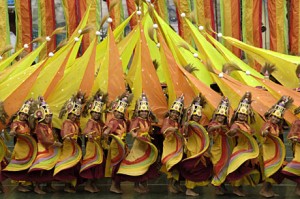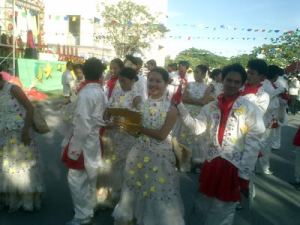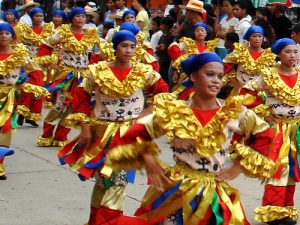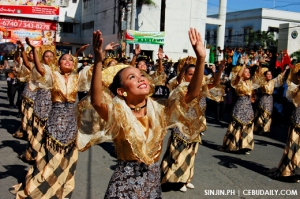Sinulog Festival
 The Sinulog festival is one of the grandest, most distinguished and most colorful festivals in the Philippines. The major festival is held each year on the third Sunday of January in Cebu City to honor the Santo Niño, or the child Jesus, who used to be the patron saint of the whole province of Cebu (since in the Catholic faith Jesus is not a saint, but God). It is fundamentally a dance ritual which remembers the Filipino people’s pagan past and their recognition of Christianity.
The Sinulog festival is one of the grandest, most distinguished and most colorful festivals in the Philippines. The major festival is held each year on the third Sunday of January in Cebu City to honor the Santo Niño, or the child Jesus, who used to be the patron saint of the whole province of Cebu (since in the Catholic faith Jesus is not a saint, but God). It is fundamentally a dance ritual which remembers the Filipino people’s pagan past and their recognition of Christianity.
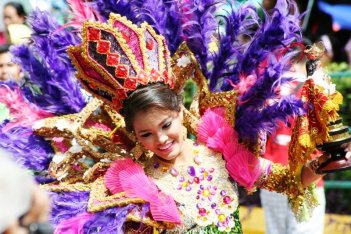 The festival features some the country’s most colorful displays of ceremony and pageantry: participants clothe in bright-colored costumes dance to the rhythm of drums and native gongs. The streets are generally lined with vendors and pedestrians all wanting to witness the street-dancing. Smaller versions of the festival are also held in different parts of the province, also to celebrate and honor the Santo Niño. There is also a Sinulog sa Kabataan, which is performed by the youths of Cebu a week before the Grand Parade.
The festival features some the country’s most colorful displays of ceremony and pageantry: participants clothe in bright-colored costumes dance to the rhythm of drums and native gongs. The streets are generally lined with vendors and pedestrians all wanting to witness the street-dancing. Smaller versions of the festival are also held in different parts of the province, also to celebrate and honor the Santo Niño. There is also a Sinulog sa Kabataan, which is performed by the youths of Cebu a week before the Grand Parade.
Recently, the cultural event has been commercialized as a tourist attraction and instead of traditional street-dancing from locals, Sinulog also came to mean a contest highlighting groups from various parts of the country. The Sinulog Contest is traditionally held in the Cebu City Sports Complex, where most of Cebu’s major provincial events are held.
19th of January (Poro, Camotes Island)
It is celebrated every January in honor of patron Sto. Niño de Poro. Beloved memoir of a living past, Tagbo is the corner stone from which this great municipality has sprung. Rich in cultural heritage and deep in spiritual values, Tagbo is a very significant event precluding the birth of a town very dear to the hearts of her sons and daughters.
20th of January (Borbon)
“Silmugi” is an old name of the town of Borbon and the festival is in honor of its patron saint for the bountiful harvest. The street dancing which is one of the highlights is participated in by the different barangays.
10th Of February (Catmon)
The town of Catmon is famous for its tasty “bodbod” and thus is the focus of the festival. The street dancing competition is participated by the different barangays has its dance movements, the movement of making the bodbod with the costumes in bodbod concept.
Kabayo Festival
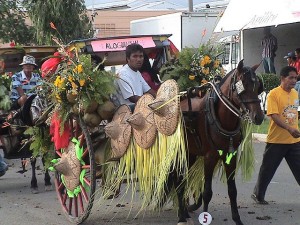 February – Movable (Mandaue City)
February – Movable (Mandaue City)
Organized by the Cebu Equine Owners, Breeders and Sportsmen Association (CEOBSA), the Kabayo festival is supported by the DOT. The festival promotes sports tourism, ecotourism and agri-industrial tourism awareness in the country. The highlights include the parade of horses, horse racing competition and the best decorated “tartanillas” or horse drawn carriages and features a bazaar and flea market.
14th of February (Consolacion)
The festival is part of the town’s commemoration of their founding anniversary. It is a mardi gras parade and street dancing along the main thoroughfares with participants using a creative design of “sarok”, a native hat used by the farmers to protect them from the heat of the sun.
Soli-Soli Festival
18th March (San Francisco, Camotes Island)
named after the soli-soli plant which abounds around the lake Danao which is used for mat, bags and hat weaving and other handicrafts. its freestyle street dancing competition uses soli-soli plant as its dominant material. The festival adds color to the feast of St. Joseph the Worker.
Tostado Festival
3rd Sunday of April (Santander)
The festival focuses on the town’s famous delicacy, the “tostado”. The street dancing which is the highlight of the festivity uses the different movements of making tostado in the dance participated in by the different barangays.
Easter Sunday (Daan Bantayan)
Starts on Easter Sunday and ends with a street dancing on the seventh day after Easter. Haladaya means “Halad kang Datu Day”, the leader of the first Malayan settlers in Daan bantayan. Highlights include the fluvial aprade where patron saints of the different barangays will be placed in decorated bancas or motorized outrigger boats and paraded in the sea.
Kabanhawan Festival
Easter Sunday (Minglanilla)
Showcases the “Sugat” in which the town is known for many years since. The street dancing depicts the joy felt by the believers when Christ is resurrected. The celebration is grander since it will be followed by a day long games and entertainment that highlights the endowment of Minglanilla’s history, trade and arts.
Bahug-bahug sa Mactan or Kadaugan sa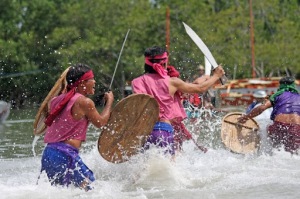 Mactan
Mactan
22nd – 27th of April (Lapu-Lapu City)
A weeklong commemoration of the historic battle of Mactan between the Spanish Conquestador Fernando Magallanes and Mactan Chieftain Lapu-Lapu. The festival features various activities highlighted by the series of musical productions culminating with the famous battle, food street and live band entertainment.
Mantawi Festival
7th of May (Mandaue City)
A showcase of the city’s historical heritage and identity promoting the city as an industrial and tourist hub, that involves the Spanish regime through street dancing, dioramas, floats, food festival, trade fair and sports event.
12th of June (Cebu City)
The Tartanilla Festival is Cebu City’s way of preserving the tartanilla (horse-drawn carriage) heritage by reviving the oldest mode of transportation to ply some of the city’s streets. The festival coincides with the city’s celebration of the country’s Independence Day starting from June 1 to 12. gaily decorated tartanillas driven by kutseros ply the streets of some of the city’s barangays and compete for several awards.
Camotes Cassava Festival
2nd week of June (Tudela, Camotes Island)
A yearly celebration of a bountiful harvest where farmers display their various cassava-based products, share their varied technical experiences in producing and processing cassava products. Among the activities are the Best Booth Contest, Poster-making Contest, search for new cassava food products, cultural night and the search for Miss Camotes Tourism.
Last week of June (Bantayan, Bantayan Island)
Palawod is the fishermen’s daily toil, their means of livelihood, their life and pride. The street dancing captures and preserves the Bantayanon’s unique traditional fishing rituals inherent to the island through dancing, music and the visual arts.
Semana Santa sa Bantayan
Holy Thursday and Good Friday (Bantayan, Bantayan Island)
Also known as “Pasko sa Kasakit” Celebrated in Holy Thursday and Good Friday. This is celebrated in the observance of the Holy Week on Bantayan Island with procession and merry making.
June – Movable (Aloguinsan)
Kinsan is the name of the town’s favorite fish that abounds in the town’s coastal area every June. It is relatively big fish, with a foot-long kinsan, weighing about three kilos considered small.
Kuyayang Festival
June – Movable (Bogo City)
Kuyayang refers to the dance movements conveying courtship and love characterized by the Bagohanon’s cariñoso character. Kuyayang mardi gras as a cultural tourism festival manifests the cultural heritage of Bogo as a place and avenue for cultural conservancy program of the city.
25th of July (Compostela)
A street dancing competition that honor’s the town’s patron saint, Señor Santiago de Apostol. History retells of a war between Christians and Muslims where the townsfolk saw and was saved by a miraculous apparition of a man riding a horse and later became known as the town’s patron saint.
Dinagat Bakasi festival
2nd week of August (Cordova)
It is a unique reinvention of the Dinagat Festival. The exotic eel locally known as “bakasi” is peculiar and abundant in Cordova. The dance replicates the gliding movement of the bakasi.
Bonga festival
9th of August (Sibonga)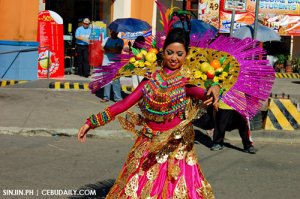
Celebrated in honor of the town’s patron saint, Our Lady of Pilar and Santa Filomena. Among its highlights is the street dancing and ritual/showdown competition. “Bunga” is a Cebuano word which means fruit in English. This festival is a thanksgiving for all the blessings and graces the Sibongahalnons have received for the abundant fruits found in their town.
Siloy Festival
Last Saturday of August (Alcoy)
The festival promotes the Mag-abo forest with its famous Black Shama or Siloy, the town’s scenic white sand beaches and dive spots and in honor of the town’s patroness Saint Rose of Lima.
Kabuhian Festival
3rd Sunday of September (Ronda)
Celebrated during the town’s fiesta that features activities like trade fair, livelihood forum and a street dancing competition participated in by the different barangays with the dance movements depicting the various livelihood program of the town.
3rd Sunday of September (Danao City)
The Karansa is a dance expressing one’s joy and happiness performed in four basic steps: The kiay, karag, kurug and kurahay that jibes with the Karansa official beat. It is celebrated during the city’s annual fiesta in honor of their patron saint, Sto. Tomas de Villanueva.
Pitlagong Festival
26th of September (Argao)
Argao’s tribute to the tradition of townsfgolk faith, celebrations, food, work, livelihood, arts and crafts. Pitlagong is an instrument for cleaning the “sugong” which is a bamboo container for coconut wine of “tuba” which is very important to the taste and quality of the tuba.
Sinanggiyaw Festival
4th of October (Dumanjug)
Sinanggi-yaw is taken from two old Cebuano words, Sinanggi meaning abundance of harvested agricultural products of the local farmers and Sayaw meaning dance. Through street dancing and field presentation. Performers is focused on three aspects: planting, harvesting and thanksgiving.
Inasal (Halad) Festival
14th – 15th of October (Talisay City)
A showcase of Talisay City’s historical heritage and identity promoting the city as an aqua and tourist hub, through street dancing as a thanksgiving offering to the city’s patroness, Sta. Teresa de Avila. Sports fest, paradeof the great personages as higantes, food festival featuring the famous “inasal” or lechon, Talisay’s roast pig being the undisputable best – golden brown, crackling crispy skin, tasty meat from secret stuffed herbs.
4th week of November (Carcar City)
The festival is in conjunction with the fiest of St. Catherine of Alexandria, the town’s patron saint. It is a cultural catalogue of the town’s historical past. Among the highlights of the festival which was named after Carcar’s old name Kabkab which is a kind of fern, is the street dancing and parade.
Kawayan Festival
2nd of December (Alegria)
“Kawayan” is the vernacular term for bamboo and is the major source of livelihood/income in Alegria. The street dancing competition is based on the kawayan and is slated during the town’s fiesta in honor of Saint Francis Javier.
Sadsad Festival
8th of December (Oslob)
In celebration of the town’s annual fiesta, “sadsad” is a form of merrymaking and thanksgiving for the blessings received for the past year from the town’s patroness, the Immaculate Conception.
8th – 9th of December (Tudela, Camotes)
The festival is a street dancing and ritual contest participated by the community. It is history retold of the richness of the town’s origin from immortals to the time of Christianization until it was separated from its mother town of Poro in the year 1911.
Pasyon sa Mandaue
Good Friday to Easter Sunday (Mandaue City)
This is a re-enactment of the passion, death and resurrection of Jesus Christ.
Fiesta sa Mandaue
May 8 – Week Long Festival (Mandaue City)
This is a week long fiesta celebration. The festival will starts May 8. The fiesta is celebrated in honour of Manduae’s Patron Saint, St. Joseph.
Feast of Santa Filomena
Celebrated in the First week of August in Tingo, Olango Island.
Tagbo Poro Festival
Celebrated every January in honor of Patron Santo Niño de Poro in Camotes Island. Tagbo is the cornerstone from which this great municipality has sprung.
Fiesta celebrated in Badian Cebu in the Month of July.
A celebration of Badian’s annual fiesta, showcasing the Cebuano and Badianganon culture, tradition, delicacies and local products, especially its famous mats (banig).
Most of us must be familiar with the banig, that humble mat one spreads on a wooden or bamboo floor at night when one goes to sleep and in the morning is simply rolled to be unfurled again in the evening. 0 percent of the wives of farmers make a living from banig weaving. The process of making it is arduous beginning with the removal of thorns from the pandan plant (from which it is made), the dyeing and finally the weaving into the humble banig. ecause it is such a tedious process making it yet pitching only a very cheap price, children of weavers frown on it as a means of livelihood. They prefer instead to work in the city as domestic helpers and factory workers.
